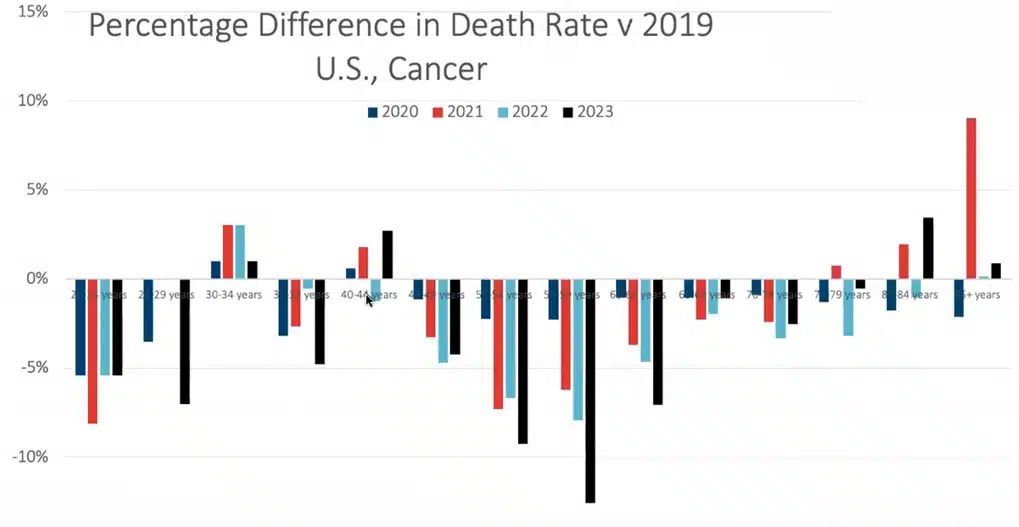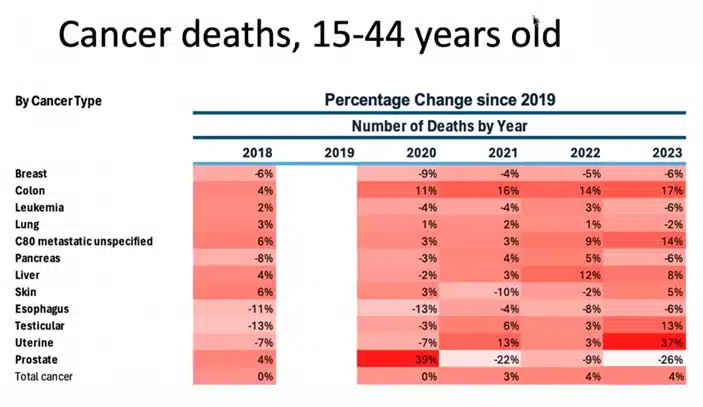Speakers: Dr. Pierre Kory, Mary Beth Pfeiffer, Mary Pat Campbell
We delve into the concerning rise of excess cancer deaths, focusing particularly on the impact seen in young adults post-COVID. Industry actuary, researcher, and data expert Mary Pat Campbell, and investigative journalist and author Mary Beth Pfeiffer joined Dr. Pierre Kory for a candid conversation.
Explore the alarming trends surrounding excess cancer deaths and the potential factors contributing to this unfortunate reality. From the latest research insights to thought-provoking analysis, this episode of the FLCCC Weekly Update sheds light on a crucial issue affecting our communities.
The incidence of cancer has been increasing for some time. But in the last few years, the number of people diagnosed with cancer has risen dramatically, especially in people under 50, causing many healthcare providers and research scientists around the world to sound the alarm.
So, why are more and younger people falling ill with cancer? Here’s an astounding prediction: The Colorectal Cancer Center at the Dana Farber Cancer Institute predicts that by 2030, the incidence of colorectal cancer in people in their 20s and 30s will increase by 90%.
Are these excess cancer deaths due to COVID alone? For answers, we turn to an unlikely hero: Life insurance industry actuary researcher Mary Pat Campbell. She’s the data expert working behind the scenes with writing partners Mary Beth Pfeiffer and Dr. Pierre Kory. Together, they’ve been asking tough questions, like:
- Why are so many Americans dying early?
- What’s behind the spike in deaths among younger, working people?
- Why did deaths in pregnancy rise 300% during the Delta wave?
Most recently, Pfeiffer and Kory co-authored an op-ed in The Washington Times highlighting the recent cancer diagnosis of Princess Catherine at age 42. She, despite having access to premier healthcare and a royal lifestyle, represents a growing trend of young adults facing cancer diagnoses.
This is not normal, and we must seek out why.
Why Are Actuaries a Good Reference For Excess Mortality?
Campbell spells out why actuaries are so tuned into the data on excess deaths:
“One of the things that keeps actuaries honest is that if we get the numbers wrong, companies lose money. So we need to do some accurate analysis of what’s actually going on.”
So, while our friends at the CDC continue to give flawed health guidance based on an alternate reality, it is the job of actuaries to focus on what’s really happening. Are there any awkward conversations taking place in the CDC’s HR department, I wonder?
If actuaries fail to do proper analysis, their employers could lose millions of dollars. This makes their work crucial for understanding why the number of deaths in cancer patients is on the rise.
Excess Deaths: Society of Actuaries Report (May 2023)
First, Campbell shows us a graph from the Society of Actuaries, published in May 2023. This graph looks at excess mortality by age group from 2020 to the end of 2022. The data comes from United States Group Life Insurance, analyzed quarter by quarter, focused on all-cause mortality.
Looking at this chart, the story emerges when you focus on the red numbers. What you’ll notice is that the biggest spikes occur between the ages of 25-45 in Q3 and Q4 of 2021. Right in the middle of the COVID-19 pandemic, right when people were first being subjected to the COVID injections.
As Campbell showed off the data, Dr. Kory asked the question on everyone’s mind, “Have you seen death numbers like this ever before?” Campbell said you’d have to go all the way back to the Spanish Flu to see that:
“The Spanish flu pandemic – and that was a special case. I mean, it was much worse than this. Okay, the Spanish flu pandemic was much worse than the COVID impact in terms of relative mortality, by the way. And it was much worse in terms of the effect… Life expectancy took a nine-year hit in one year.”
Percentage Difference in Cancer Death Rate (Feb 2024)
The above chart looks at data from CDC Wonder, a freely accessible public health database, focusing on the percentage difference of cancer deaths. This graph compares the years 2020-2023 against a pre-pandemic benchmark of 2019.
Remember the age groups of 25-45 who were getting hit the hardest by the spike in all-cause mortality? Based on this data, we can see that cancer deaths are on the rise in those age groups specifically.
Cancer Deaths in 15-44 Year Old’s by Cancer Type
When we focus on cancer deaths by cancer type, the picture becomes bleaker. The one that will jump out: colon cancer. Campbell clarifies that colon cancer has been on the rise since before COVID came into the picture. But again, when we get to 2021, we see an immediate 5% increase.
Is it because of the COVID shots? At the very least, we should be asking the question.
Campbell noted another disturbing trend: unspecified cancer deaths. In the webinar above, Dr. Kory explains that some cancers are so aggressive they’re called “poorly differentiated”. In these cases, pathologists can’t find the origin. And if you look at the chart above, those unspecified cancers are up as high as 14% in 2023.
A Closer Look at What Lies Ahead
As we’ve seen, the rise in cancer deaths, in young adults especially, is alarming. As Mary Pat Campbell notes, it’s not just cancer, but a range of ailments including diabetes and heart disease.
These are not just numbers; they’re warning signs that we need to pay attention to. Campbell’s work helps us understand that these trends are something everyone, from health experts to everyday people, should be concerned about.
With an observable rise of this magnitude, FLCCC is doing everything we can to improve cancer outcomes:
- FLCCC co-founder Dr. Marik has written Cancer Care, a monograph focused on metabolic interventions and repurposed drugs to reduce cancer.
- We’ve started conducting a 5-year observational cancer study aimed at reducing death via repurposed medicines.
- Our Weekly Webinar hosts some of the best cancer innovators, like Dr. Thomas Seyfried and Dr. Kathleen Ruddy.
- We’re dedicated to educating the public on practical cancer solutions via written articles too.
- We create video resources for education purposes too, like 8 steps to reduce your risk of cancer.
All of this work is made possible by the generous donations of our supporters.








